

MAG-GEN Generating The Future
|
The purpose of this document is to educate you on the research and discoveries that I have made while studying magnetism and permanent magnets. I hope this brings you to a better understanding of how magnetism works and how it can be harnessed to produce power using no energy other than the energy contained within its own magnetic field. At the time of this writing I am 29 years old and have been tinkering with magnets for about 17 years. During that time I have picked up a working knowledge of basic construction skills, electronics, magnetics, and have devised several inventions that I never saw out to patent form. I have a very high I.Q. and aptitude, so conceptual thought comes very easily for me as long as a good dictionary is nearby. As for formal training or college degrees I have none. This, in my opinion, has given me the opportunity to look at concepts with a mind set that is not pre-programmed to “proven laws” or how things have “always been” when dealing with physics or magnetic theories. While trying to find research material on magnets, I quickly began to realize that no one really knew what a magnet was.That prompted me to dig deeper and I sometimes found myself with concepts of magnetism that most engineers or physicist would not even consider, because these theories did not conform to modern schools of thought. So let me explain what I believe a magnet is, and at the same time what it’s not. A magnet is made up of three things. 1. The Vessel- When you are holding a magnet in your hand what is physically touching the palm of your hand is not a magnet. It’s a rock or a piece of metal. It is a vessel or portal if you will, that the magnetic field is flowing through. To prove this to you lets do a little experiment. Take a stack of five round craft magnets that you can get from the radio store and reverse the one on the end so that it wants to fly away, then tape it in place on the stack. Build a small frame from the cardboard backing of a writing tablet like the one you see below. Also cut out a small swing and place two magnets one on each side of the little swing so that they attract and hold themselves in place. Now as you move your stack of magnets towards the swing it will want to swing towards the stack. The closer you get to the swing magnets, the swing will suddenly fly away |
|
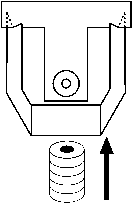 |
What you have done is to basically push the entire magnetic field out of its vessel. Both north and south are sitting out there on the end of your stack of magnets. The bad part is that by holding the magnets in this forced pole to pole manner will quickly kill the magnets strength and usability. 2. The Field- The field is flowing through this vessel in two directions. Into the north and into the south, then exiting both through their respective opposite poles. |
|
3. The Magnets- I use this term now to describe that which is actually making up the field. You can call them nuons, muons, electrons or vectrons. No matter what you call them, these are the true magnets. These magnets operate at a sub-atomic level. They are smaller than the size of an atom. I read about this last description from a man named Edward Leedskalkin, the eccentric man who built Coral Castle in Homestead, Florida. From 1930-1940 he surpassed even the most modern construction methods known by today’s standards and built his home from megalithic pieces of coralstone that he harvested with just crude hand made tools. These infinitely small “magnets” as he calls them, fly in one end of the vessel and out the other. Sometimes they fly away, but most time they just go right back to the other end and start over. This is a great way of looking at magnets. He also said that there were south pole magnets and north pole magnets. One going in the north end and the other in the south end. I’m very sure of this. This is why a dipole magnet placed in another dipole magnets field will not rotate or produce some kind of work. It is basically being cancelled out. Equal amounts of south and north pole “magnets” flowing in opposite directions will not produce any work when introduced into the field of another magnet be it larger or smaller, unless there is an uneven amount of one or the other poles “magnets”. Please understand that this is my opinion of what Mr. Leedskalkin was trying to say. His writings are very difficult to understand. But I do believe that what I have grasped from his writings is, at least, a more accurate description of the way a magnetic field works. To get to a point for you, these “magnets” do not operate on the same physics playing field that anything else does. First off these guys are in almost perpetual motion. I mean if they are flying in one end and out the other, what is driving them? Where is the fuel, or the waste? There isn’t any. Also, If they are flying out of one end and into the other what is tethering them to the vessel to do so? And..... magnets last for thousands upon thousands of years if they are not damaged by heat or struck very hard. Take a 110volt electromagnet and attach it to an iron beam. Now take a nice strong neo magnet and attach it to the same beam. Now stick a 1 lb piece of metal to each of these. The electromagnet is using energy to generate the field to hold the metal in place. And the neo magnet is using what to hold the metal and keep it from hitting the floor? Energy? Nope. Now you might say that it took quite a bit of energy to make that neo magnet. OK, good try. I bought that neo magnet for $1 and the electro-magnet has now been running for twenty years at about $35 bucks a year. How much energy do you really think it took to make that neo magnet? How long do you think it will hold that piece of metal up there, 100 years? 1,000 years? These little “magnets” are as close to a physicists hearts desire as perpetual motion can get. So how does one take advantage of these little free energy machines? Well, that’s where Mr. Stewart A. Harris comes in. Mr. Harris wrote a paper called “Theory of Magnetic Instability”. Along with this paper and many other concepts and designs, I have put together MAG-GEN. (Magnetic Generator) The “Theory of Magnetic Instability”, or TOMI from now on, is a phenomenal piece of research. Mr. Harris was able to show in his paper that a magnetic pole can be isolated, and that there are two levels of energy in a magnet not just one. Let me clarify. James Clerk Maxwell’s second law of electricity and magnetism dictates that there is no isolated magnetic pole. “Monopole” So a tri-pole interaction is disallowed as a result of this thinking. Because of course, no monopoles exist in the universe that we know of. However, any pole that is in a magnetic field, and is isolated can effectively act as a monopole. This is the heart of TOMI. To paraphrase TOMI and give you a better understanding of what this means, let’s do an experiment. Take three bar magnets magnetized through their lengths. Set two of them side by side in an attracting position as seen in the next figure. |
|
|
|
Now place the third magnet in between as seen. You will see that the north pole of the magnet in the center is only interacting with the bar magnet on the left, that would be a tri-pole configurment. The same would be true of the South pole of the center magnet interacting with the right hand magnet. Now, Let’s name these things so they can be understood easier. The two magnets that are parallel to one another we will call “tracks” (paths which can be followed). The center magnet we will call the “runner” (the free moving piece of our model for now). |
|
The picture you just looked at is the basis for all TOMI systems. However this setup is not yet a TOMI model. The runner placed into the tracks as you see, will immediately move to a midpoint in the tracks and STOP! This is an experiment that shows “magnetic stability”. Meaning that when the push from the bottom half of the tracks equals the pull from the top half of the tracks, motion ceases. The runner magnet has found a neutral or dead zone. However in a TOMI setup, there never is a “stability”. There is always instability. Let me explain. N-----------I-------------S The above is a magnet. You will notice that it has two poles and a dead zone in between. (when in a tri-pole interaction) However in TOMI we use that space in between by creating cross cuts perpendicular to the end poles. This in effect gives us a “manypoled” magnet. As you see below. N--s/n-s/n-s/n-s/n-s/n--S |
|
 |
This crosscuting gives the magnet it’s “instability”. By that statement I mean for you to understand that when a third pole is brought into play it does not find a resting place or dead zone in the center of the bar magnets magnetic fields. Instead it will want to continue to move the entire length of the magnets. |
| There is an important thing to know about the crosscuts that you have introduced and how they come into play with the runner magnet. The runner magnet must be larger in field surface area than one of the new miniature magnets that the crosscuts have created for the “instability” to happen. It is also important to only cut one face of each track in this setup. | |
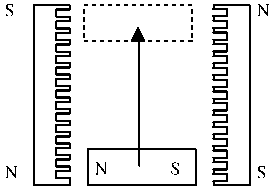 |
As you will see in the figure above, the runner will want to travel the entire distance of the new TOMI tracks. This in effect doubles the ability to do work in a magnet. If you want to argue that the cross cutting added energy to the magnet then I will ask you to explain why the uncut faces of the TOMI does not make the runner travel the full length of the tracks. Or for the sake of proof grind the crosscuts off, you will never see anything but a loss despite the fact that you have argued that doing work just added energy. Notice that this process of crosscutting then grinding off the cuts, reduces mass, which in accord with Energy being equivalent to Mass, should dictate a continuous loss or destruction of energy. Wrong! |
|
Take those same ground down magnets and cross cut new lines in them and the runner magnet will once again travel the whole distance. These tracks will work on a flat plain, but will work even more amazingly so at a 90 degree upright position, literally levitating the runner magnet to the tracks full height. These tracks could be placed on the sides of a ramp and produce work. Place your runner at the base of the ramp, it will then climb the ramp. If the TOMI tracks are placed hanging just over the edge of the top of your ramp, the runner will climb to the top of the ramp and then fall off the edge. By placing another ramp at the base of the first one, the falling runner will basically reset itself and start climbing this new ramp. And on and on...... Example of ramps in series. o/\/\/\/\/\_______o Mr. Harris devised several methods to use his discovery one in which a runner would climb a ramp then fall through a trap door and trip a latch to allow the ramp to rotate thereby resetting itself to climb the ramp again and start all over. This brings us to my discoveries. I have been building my own and trying to duplicate other free energy devices for some time. I have been trying to work the TOMI principle into them since I found the paper on the internet in late 2000. I have seen other concepts and devices that are truly amazing in their ability to create energy from seemingly nothing. However most of the devices used timing switches and electric circuits. What I wanted to do was prove that energy could be produced from permanent magnets alone without the need for fancy timing gismos and wiring that could hide a lie. I wanted basic, basic, and nothing else. I started to build devices like the Minato bicycle wheel, and the Robert Callaway wheel designs. These and others like them were very hard to try and duplicate due to their needing an amazing amount of patience to just tune the flow of the magnetic fields. Another machine that seemed almost impossible to tune was the Wesley Gary magnetic motor. Mr. Gary was a gentleman from Pennsylvania that lived in the late 1800’s. Some of his patents would blow your mind just by how simple they are and that the logic behind them is totally solid. While working with these devices I started to notice common threads of thought. One device would use a lever to block the magnetic attraction between two magnets while another would simply taper the field away from other magnets while spinning away. What these concepts were trying to do was to overcome the major obstacle of the permanent magnet perpetual motion machine... The “magnetic lock”. This is the point in a cycle where two or more magnets would come into play and not want to let go of each other. Thus the kinetic energy built up within the device would have to be great enough to break the magnetic lock, and reset the device so as to start another cycle. Much easier said that done until MAG-GEN. What I have done is taken what I have learned and devised a way to not have the magnetic lock even come into play. Not to try and over come it, just get rid of the thing. I mean it‘s useless anyway Right?. In the TOMI device the magnetic lock occurs when the runner has traveled the full length of the tracks and got stuck at the top. |
|
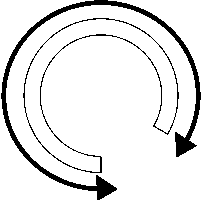 |
In a gravity setup like the ramps and other methods of using TOMI the traveling distance and the bulk of the ramps really produce a very low amount of work in relation to what they can produce if one took away the ramp and used the setup on a flat spinning plane instead. So take a look at the picture to the left and imagine the curved bar magnet is magnetized throughout the circumference.The poles would be in line with the arrows. |
| This would be a perfect ring magnet except for the fact that a 60 degree segment is missing from it. The reason for that is that if the segment was still there the magnetic field would be continuous and it would then be a closed loop so to speak. That would be useless. | |
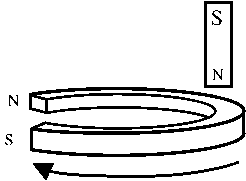 |
Here you can see the interaction of a roller or now we would call this a drive magnet. Imagining the curved magnet on a rotating plane, you will see when the roller comes int play force will move the curved magnet in a certain direction. If the segment were there the magnet would not move. |
| With this segment missing we can actually magnetize the arc and use it to create a TOMI track. | |
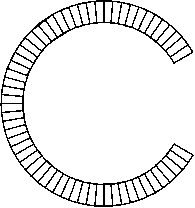 |
When I first came across this idea I flipped out. I ran around dancing thinking I solved the riddle of the universe. Well not quite. I still had to over come the magnetic lock. You see as you bring the runner(which we will now call the “Drive Magnet”) into play with this track, it still came to a halt when north met south.(magnetic lock)
|
| So what I came up with was a TOMI within a TOMI, as you see here. | |
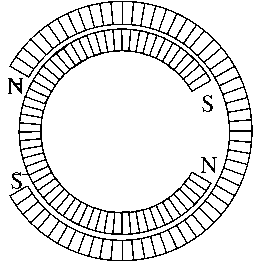 |
This is the heart of MAG-GEN. By placing a TOMI track within another TOMI track you create a partial loop in which by the slightest movement of the drive magnet you can be operating in one track then the other. I hope by the picture it is clear that these two tracks are not touching. They are on the same plane, and there is about a quarter inch gap in-between them. By not touching, their personal magnetic fields are kept strong and the magnetic loop is only partially created. |
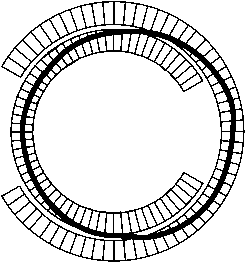 |
What this does is create a magnetic path for the drive magnet (runner) to travel on.The dark line here represents that path. Know that the magnetic tracks do not wobble. It is the lighter drive magnets that move on this path as the magnets spin Now by pancaking the drive magnet in between two of these double track TOMI setups you have MAG-GEN.In fact you can double the output of the device by using two or more drive magnets and having them move in time with each other. I have devised several ways of having the drive magnets travel their path. |
| One of which would be a non-magnetic carriage connecting the two drive magnets to each other and being driven by an off center pin attached to the plane of the TOMI tracks and using their kinetic energy to drive the carriage back and forth between the magnetic fields of the double TOMI designs. | |
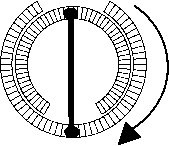 |
In this next series of pictures you will see the movement in a series of four stages. In Stage 1 you see the drive arm with one drive magnet in the inner TOMI track, and the lower drive magnet in the outer TOMI track. This will cause a rotation of the entire disk that the TOMI tracks rest upon. |
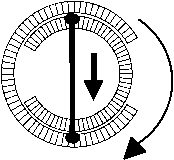 |
In Stage 2 you see the disk has rotated 90 degrees clockwise. The movement of the drive arm has been upwards. This movement is bringing the drive magnets into the in-between stage where they are now in both the outer TOMI tracks field and the field of the inner TOMI track. This is a transition stage for the MAG-GEN. |
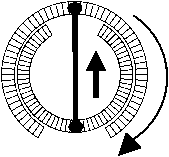 |
In Stage 3 You see another 90 degree clockwise rotation has occured. The drive magnets are in their full upright position. The upper drive magnet is now located completely in the outer TOMI tracks magnetic field and the lower drive magnet is completely in the inner TOMI tracks magnetic field. |
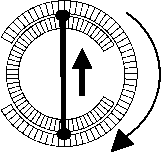 |
In Stage 4 you see another 90 degrees has been turned in the clockwise direction. The drive arm is once again in the transition stage of movement. This is the stage where the drive arm is now crossing both of the TOMI tracks, and going down back to the original starting position that we found ourselves seeing in Stage 1. |
|
There are many different ways in going about moving the drive magnets. Another that I have devised is to have a center gear built in to the disk then have two or more gears one to each side of the center gear each one containing a drive magnet that rotates back and fourth between the TOMI tracks. I hope that this has been a proper enough explanation of my MAG-GEN concept for you to grasp the importance of what it implicates for the future. There are many devices out there that have proven the existence of free energy and ways to create it. Search on your own and find these devices. All the majior search engines will bring up many sites that describe different methods and devices that you can study to produce your own concepts. Draw your own conclusions about these machines. Try not to be misled by shams and con artists. We can help the world, and it is me and you who has to do it. No one else is going to do that for us. In the near future I hope to produce products that you can purchase using the concepts that I have described for you here. In the mean time look up the information that is already available about free energy, hydrogen engines, water engines, pmm’s (pepetual motion machines), ram pumps, xogen, and motionless electromagnetic generators. You can also search for various inventors who are out there right now changing the face of energy and physics one invention at a time like, John Bedini, Ohsako, Minato, Al Francour, and many many others. With all my love, Phillip W. Dunham Jr. 727-446-9952 philspad@yahoo.com The following are web locations for further information. Theory Of Magnetic Instability (Stewart Harris) http://www.fortunecity.com/greenfield/bp/16/magnetic.htm Edward Leedskalkin Information on Wesley Gary and magnetic neutral lines http://geoffegel.tripod.com/garymotor.htm The push/pull swing magnet experiment http://geoffegel.tripod.com/magnet1.htm Other Alternative Energy Sites Jean Louis Naudin http://members.aol.com/jnaudin509/index.htm John Bedini Geoff Egel http://geoffegel.tripod.com/index.htm Keely Net |
|
From the Author of this article
Hello,
I have been getting quite a bit of response so have I setup an egroup at...
Mag gen newsgroup
This way I will not detract from anyone elses work.
Please post any ideas or questions there and I will be happy to
respond.
My Best,
Phillip Dunham
